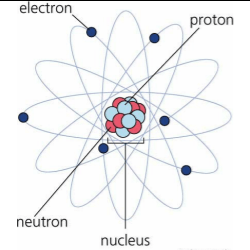Matter is...
anything that has mass and takes up space.
True or False?
Neutrons are positively charged particles.
False! Protons are positively charged. Neutrons are Neutral!
The smallest particles of matter are called_____.
a. Animals
b. atoms
c. Periodic Table.
d. Electron Cloud
B. ATOMS
Neutrally charged particles are known as
a. electrons
b. protons
c. neutrons
d. nuclei
c. neutrons
What are the steps of the Scientific Method?
Make an Observation, Ask a Question, Form a hypothesis/make a prediction, Perform a test (Experiment), Record Results, Report conclusions
Negatively charged particles are called
electrons
True or False?
There are more than 1 million known elements that make up all matter.
False
A _______ is a combination of two or more substances that do not lose their identifying characteristics when combined.
a. mixture
b. density
c. solution
d. compound
A. Mixture
______ are the smallest whole bit of a substance, and are made of two or more atoms.
a. molecules
b. electrons
c. compounds
d. mixtures
Molecules
How does temperature affect matter (Double Points)
As its temperature increases, many kinds of matter change from a solid to a liquid to a gas. As its temperature decreases, that matter changes from a gas to a liquid to a solid. As the temperature increases, the particles begin to move faster and cause them to change states.
What are compounds?
When two or more elements combine to form a new substance.
True or False?
A solution is a mixture in which one substance completely dissolves in another.
True!
Water and table salt are both examples of
a. mixtures
b. compounds
c. elements
d. solutions
B. compounds
What are the four states of matter?
a. Solid, Liquid, Gas, Star
b. Plasma, Gas, Liquid, Solid
c. Plasma, Glass, Water, Ice
d. Solid, Liquid, Gas, Energy
b. Plasma, gas, liquid, solid
Compare the three most common states of matter (Depending on your answer you could earn double points here!)
Solids keep their shape. Particles in a solid are packed tightly together and vibrate back and forth. Liquids take the shape of their container. Particles in a liquid are further apart than those of a solid but closer together than those of a gas. Particles in a liquid move faster than those of a solid but not as fast as those of a liquid. A gas's shape, volume, and size will change depending on the container. Particles in a gas are very spread out and move quickly in all directions.
Molecules
The smallest whole bit of a substance.
True or False?
All matter, regardless of its size, shape, or color, is made up of particles too small to be seen by the eye.
True
Electrons are located in an atoms ________.
a. nucleus
b. Electron Cloud
c. Periodic Table
d. Element
b. electron cloud
All things, living and dead, are made of
A. Solutions
B. Mixtures
C. Compounds
D. Matter
D. Matter
How can a balloon be used to demonstrate that matter is made of particles too small to be seen.
You can show that a matter is too small to be seen by blowing up the balloon. It shows you that even though you cannot see the matter (air) that we blow out, it does have mass and it takes up space causing the balloon to expand. Also, you can feel the air come out of the balloon even though you cannot see it.
Define: Atoms
The smallest particles of matter
True or False?
Mass is neither created nor destroyed in a chemical reaction?
True! This is the LAW OF CONSERVATION OF MASS!
Protons and neutrons are located in an atoms
a. proton cloud
b. nucleus
c. molecule
d. element
b. nucleus
Molecules are made of _____ or more atoms.
a. one
b. two
c. three
d. four
b. two
Draw a diagram of an atom on the whiteboard. Label the protons, neutrons, electrons, electron cloud, and nucleus.
